A Benevity Impact Labs Report
The State of
Corporate Purpose 2023
Published on May 10, 2023
Coming out of the crises that shaped the past few years, companies are now finding themselves navigating a new wave of uncertainty: a global economic downturn.
Interest rates and inflation have risen to new highs, workforce reductions are widespread and a cost-of-living crisis has left communities and nonprofits wondering how they will persevere through a time of increased need.
Amidst this backdrop, companies are reckoning with challenges of another magnitude — acting as a cultural unifier in an uncharted, hybrid work world where employee engagement, productivity and retention are fraught. Employee expectation remains high that companies sustain action around diversity, equity and inclusion (DEI), the climate crisis, and humanitarian needs and global inequity exacerbated by disaster and conflict — while companies also carefully consider how they advance much-needed progress in the face of ongoing politicization and polarization.
While these issues may seem disparate, they are inextricably intertwined. They all stem from the growing need for people to have more meaning and a positive impact on the world — in their lives, at work and through the brands they buy from.
If one thing is certain during this period, it’s that corporate purpose can not only sustain us, it can help to pave the way forward through difficult times. Companies who lead with purpose will be positioned to support communities at home and abroad through heightened economic pressure. Purpose engages and retains top talent. It improves our sense of connection, belonging and well-being. And it advances society on the most pressing issues that require our attention and action.
In 2023, companies who maximize their social investments and leverage purpose to unify their workforce and drive positive change will see societal and business impact that long outlasts a recession.
2022 in review: a year of record-breaking impact
Benevity welcomed almost 200 new companies to our community in 2022 — impressive, purpose-driven brands that elevate our collective impact.
purpose-driven companies
in donations
volunteer hours tracked
grants worth $2.3B
positive micro-actions taken
unique causes supported
Donations held steady
In 2022, the increase in overall donation dollars correlated with the increase in the number of new givers on the Benevity platform. Individuals donated larger sums of money, but donated less frequently, leading to a 4% increase in user-donated dollars per individual year over year. Companies backed their people by providing matching dollars at a slightly higher rate than in 2021.
Giving trends in 2022
increase in total donation dollars year over year, including corporate matches
overall annual average per donor (user + match dollars)
increase in user donation dollars per individual was seen over the year
decline in average frequency of donations per donor from 10.6 times to 9.6 times
increase in average user amount per donation from $61 to $70
average annual dollars per donor (user dollars only) compared to $643 in 2021
Volunteering soared to new heights
Volunteerism was a bright light in 2022 for employees, companies and the communities they care about. It bounced back with remarkable buoyancy after a period of decline as a result of COVID-19.
Eighty-six percent of companies now have active volunteering programs — an almost 10% increase year over year, demonstrating the continued belief in volunteering as a way to drive social, team and business impact. New companies who joined Benevity, many with robust volunteering programs, brought in committed volunteers — with some companies logging upward of 380,000 hours in their first year. Existing companies in our community also saw a massive spike in total volunteering hours recorded, resulting in a staggering 61% increase.
A deeper look at the 14.3 million volunteer hours recorded in 2022 reveals themes of “return to normal.”
As the world opened up, volunteers returned to their previous commitments that were largely shuttered during the pandemic — boys and girls clubs, youth athletics associations, education-related volunteering and a myriad of other service organizations and activities.
Notably, and unsurprisingly, there was plenty of volunteerism directed at organizations focused on resettling refugees from Ukraine — providing financial, food and shelter supports for those displaced. People rose together to support the wave of people fleeing conflict to safety, but instability in a new country required countless hands and hours to manage logistics, deliver comfort and support the transition of families and individuals on the move.
Over the past two years, we’ve also seen growth in volunteer acts of kindness♥ — a term for prosocial acts, like picking up groceries for an elderly neighbor or cleaning up a local park, that are in support of groups or individuals where the beneficiary is not a registered organization. These positive actions have taken hold in corporate purpose programs because they acknowledge the small acts that can improve individuals’ circumstances outside of formal volunteering and provide an entry point for employees to get involved in giving time. These types of volunteer opportunities enable people to learn, take action or help others, and in many cases participants receive reward funds that can then be donated to a nonprofit of their choice. Eighty-one percent of companies with volunteering include volunteer acts of kindness in their programs.
Virtual volunteering remains a way to connect employees across geographies and remote and hybrid work contexts, and it engages more people individually in skills-based opportunities. In 2022, 30% of volunteering opportunities were virtual compared to 44% in 2021. While the return to in-person volunteering contributed to this 14-point drop, the virtual volunteering rate remains well above the pre-pandemic benchmark of 12% — indicating there’s a continued need for these kinds of inclusive activities that help to create community for distributed employees.
Volunteering trends in 2022
of companies have volunteering programs — an almost 10% increase year over year
increase in recorded volunteering hours
volunteers gave time
of hours tracked were volunteer acts of kindness and this remained stable in 2022 (vs. 40% in 2021 and 38% in 2020)
of companies with volunteering programs included volunteer acts of kindness
of volunteering opportunities in 2022 were virtual compared to 44% in 2021
Employee participation rose
Carried largely by the increase in volunteerism, the overall participation rate♦ in companies’ employee giving, volunteering or micro-actions programs was up by over 11% year over year. While almost 30% of companies saw reductions in their volunteering participation rates, another 30% saw their participation rates double or more, easily offsetting those declines.
Although donation participation was down for just over half of companies, overall donation participation rates held at 10.1%, exactly the same as in 2021.
Participation trends in 2022

Purpose and polarization are going head-to-head
Business remains the most trusted institution globally, according to the 2023 Edelman Trust Barometer. With this trust comes increased expectations to do the right thing on key societal issues. Companies who embrace this responsibility are a source of hope for driving positive change on the most challenging issues we face — whether that’s racial inequity and injustice or an intensifying climate crisis.
The good news is that as the world expected and demanded more from businesses in the past few years, many readily answered the call. When stakeholders explicitly told them they needed to step up, be vocal and take a stand, they used their power and platform for good. From supporting frontline workers, vulnerable populations and low-income countries that lacked vaccine access in the face of COVID-19, to making public commitments and acting to further racial justice and equity for Black, Indigenous and Asian people who were impacted by devastating events of racial hate, corporations proved they could be counted on in times of crisis. And those who meaningfully showed up were met with great accolades and allegiances, but also — in some cases — backlash, embroiling business in yet another threat to progress: polarization.
In this economically turbulent period, it’s become more difficult to decouple today’s societal issues from political undercurrents. In a time rife with rollbacks around access to reproductive and gender-affirming healthcare for women and LGBTQ people and an ongoing war in Ukraine, many companies are now finding themselves in a double bind: Avoid action and risk impeding much-needed progress and alienating a socially driven population. Or veer too deep into issues deemed political, tip into polarization and face negativity.
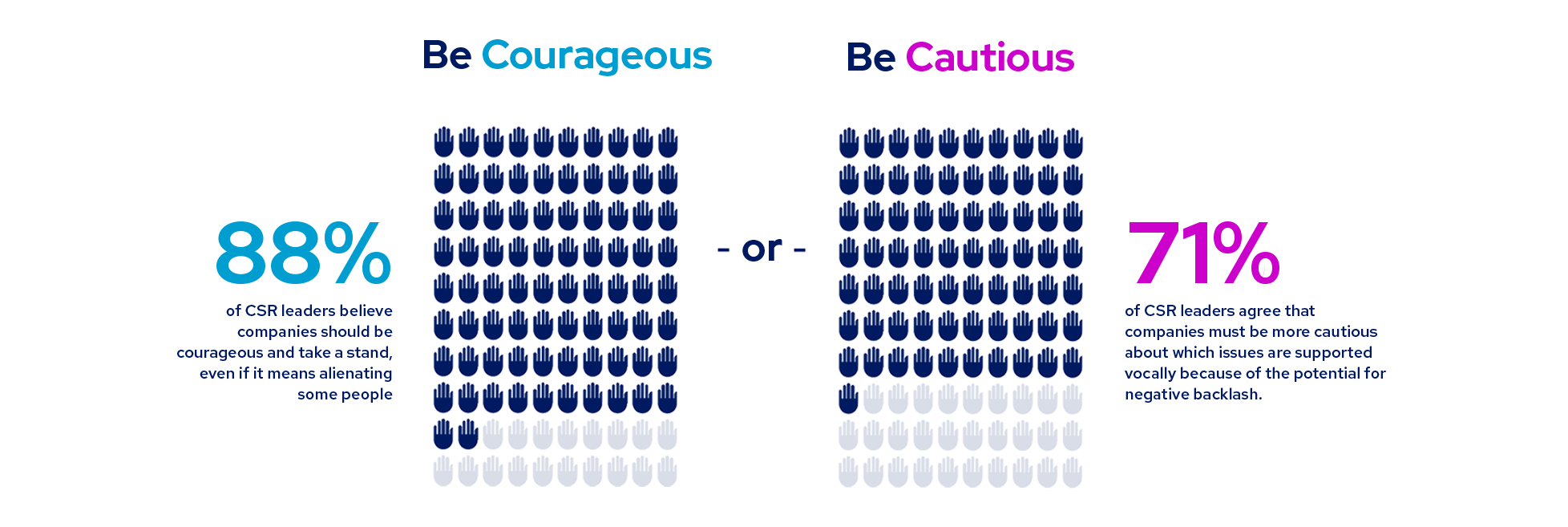
Source: Benevity 2023 CSR Leaders Survey
Regardless of where businesses stand on when, how or even if they will show up publicly on divisive yet important societal issues, employees remain invested in the idea that a company’s role is to help their people grow and evolve through consciousness raising, continuous learning and opportunities to make a positive impact.
The role of business in bettering employees
As corporate purpose programs mature and increase in importance, companies are recognizing their role is not only bettering the communities in which they operate but supporting their people in becoming better humans. What better actually looks like will vary from company to company.
In 2023, companies are left contemplating how they will straddle the seemingly impossible expectation to make progress on major issues, better their people and act as a unifying force for society in the face of politicization — all while the pressure of profits looms. It’s unsurprising that tension prevails among CSR leaders:

As companies consider balancing competing corporate and societal needs without adding to further division, every business will need to reflect on what better looks like for them and then use it as a North Star to guide them through the next period of uncertainty. The question remains: How do you do this in a practical way that meaningfully represents your company’s mission and the values of your stakeholders?
93%
of CSR leaders believe that companies should act as a unifying force for humanity more than they did in previous years.
Quiet giving is on the rise
The global economic downturn is placing pressure on companies to tighten budgets and consider pullbacks across areas of spend, with financial investment in corporate programs related to purpose and impact being put to the test.
In spite of this pressure, companies remain committed to being a force for good — but more quietly than in the past two years. In 2023, we expect fewer bold statements from companies on every hot-button issue and more compassionate action and communications focused on their employees and the local communities where they can make a more pronounced impact — a trend we’re calling “quiet giving.”
Qui•et Giv•ing
[ kwī-ət giv-iŋ ] verb
How companies will demonstrate their corporate purpose during difficult times, characterized by turning their focus inward to center investments on their employees and local communities
Companies are investing close to home

Companies will be leaning in to support those closest to them, namely employees who are experiencing personal challenges related to the economy — increased costs of living, decreased well-being, plunging productivity, according to the U.S. Bureau of Labor Statistics, and difficulty maintaining a sense of connection to their colleagues, communities and company.
This new inward focus will manifest through different types of social investments than in years past. In 2023, companies are forecasting the largest increase in investment in employee climate action programs, followed by employee learning and social action programs; diversity, equity and inclusion (DEI) initiatives; employee resource groups (ERGs) and volunteering.
Volunteering, which was a bright spot for corporate purpose programs in 2022, will move further into the limelight in 2023 because it offers an answer to many of the challenges facing employees, communities and companies right now. Company-led volunteering initiatives provide an opportunity for employees to meaningfully connect with each other and make an impact in local communities that sorely need support. Doubling down on employee volunteering programs can help to address the labor shortage nonprofits are currently experiencing.
And research in the Journal of Happiness Studies has shown that spending time in service to others can improve well-being, which can come as a restorative reprieve for many during difficult times.

While companies will prioritize the needs of their people, they will also remain resolute in maintaining their social investments — serving as a critical source of support through grants and partnerships with nonprofits serving vulnerable populations.

Despite the downturn, we can take comfort in knowing that most companies are maintaining their investments to support key populations and issues and causes close to home while continuing to back their people in making a positive impact at work and out in the world in the ways that matter most to them. Companies who have been committed to purpose for the long term understand the resilience and value it brings to their stakeholders and communities, and they know that now is not the time to pull back.
Companies are becoming communities
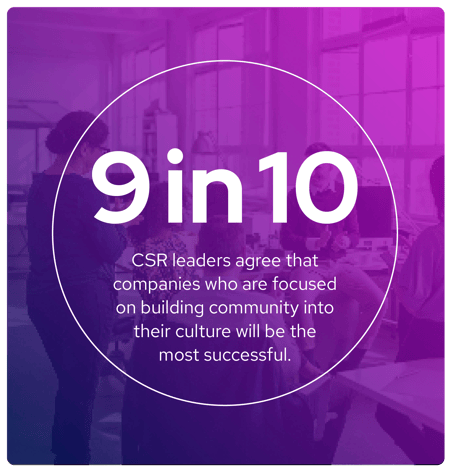 The future of work is here and it contains multitudes. Digital transformation, shifts to remote and hybrid work and the growing adoption of artificial intelligence are all reshaping work as we know it. Plus, recent viral trends like conscious quitting and rage applying have been popularized by Gen Zers and millennials, who make up nearly 50% of the workforce this year, according to Gallup.
The future of work is here and it contains multitudes. Digital transformation, shifts to remote and hybrid work and the growing adoption of artificial intelligence are all reshaping work as we know it. Plus, recent viral trends like conscious quitting and rage applying have been popularized by Gen Zers and millennials, who make up nearly 50% of the workforce this year, according to Gallup.
They’re showing that work still leaves much to be desired as Gallup says employee engagement continues to decline. Forty-four percent of U.S. Gen Z and millennial employees report they have previously resigned from a job, according to the 2023 Net Positive Employee Barometer by Paul Polman, because the values of that company did not align with their own. Clearly, they’re looking for more than just a paycheck.
Forward-thinking brands already know the future of work is one of purpose-driven communities where employees come together to learn, grow, take action and make a difference together. But while many companies know that connection through community building is paramount, it’s become harder to foster over the past few years amidst the compounding realities of remote and hybrid work, high employee turnover and economic uncertainty resulting in workforce reductions. Companies remain split on how they solve for this. Some are employing sweeping return-to-office mandates while others are striving to get at the heart of the connection issue by viewing it as an opportunity. One thing is clear: Companies who focus on community building will be the talent magnets of the future.
Community building through volunteering
 Where does community begin and thrive? In a hybrid world where more companies have more people in more places than ever, companies need proven ways to connect everyone across remote and in-person contexts. In 2023, more companies will use their corporate purpose programs to bring their people together and strengthen culture, with volunteering acting as a key lever in achieving this.
Where does community begin and thrive? In a hybrid world where more companies have more people in more places than ever, companies need proven ways to connect everyone across remote and in-person contexts. In 2023, more companies will use their corporate purpose programs to bring their people together and strengthen culture, with volunteering acting as a key lever in achieving this.
In 2022, volunteering came back in a big way with a full-fledged return to in-person, team volunteering — especially in cities where companies are intentionally trying to create community by bringing hybrid workers together at offices or at nonprofits to be of service. Seventy-four percent of CSR leaders will be increasing their use of in-person volunteering around office locations to improve employee connection.
While volunteering offers a valuable opportunity to bring employees together and help them make a positive impact, meeting their expectations in this way can also have a material impact on a company’s bottom line by aiding in attracting and retaining top talent. Data from Benevity’s Talent Retention Study revealed a reduction in turnover among all employee cohorts that participated in their company’s corporate purpose program. The association between purpose and retention is even more pronounced for newer employees, who see a 52% lower turnover when they participate — whether that’s through volunteering, charitable giving or other positive actions.

Though volunteering will be central to community building in 2023, we will also see investment in employee resource groups (ERGs) to drive deeper connections and build belonging alongside corporate purpose programs, with 92% of CSR leaders indicating that ERGs are an important way for companies to create community.
Today’s workplaces are a microcosm for society’s challenges, and it’s increasingly becoming the role of companies to provide a place where connection, learning, growth and positive action can take place as a part of one’s job — not separate from it.
Investing in company culture in this way will continue to drive greater social, team and business impact, further cementing the role of purpose in the workplace and fundamentally shifting companies into communities.
ERGs are now a must-have strategy in DEI
 A through line across 2023 is the resounding belief in diversity, equity and inclusion (DEI) investments as a value to society, individuals and business.
A through line across 2023 is the resounding belief in diversity, equity and inclusion (DEI) investments as a value to society, individuals and business.
Ninety percent of CSR leaders believe it is up to companies to help every employee become more aware of bias and develop more inclusive behaviors that can create more diverse cultures.
But ask corporate purpose leaders about DEI and there’s one thing they’ll all agree on: Their companies are not leaders at it yet. Despite years of anti-bias training, setting targets and being vocal about commitments, goals and achievements, companies still struggle to make the progress that employees and DEI leaders expect, even though the business and societal benefits are well understood.
It’s clear companies recognize there is more to be done to move the dial, and they’re embracing their integral role in advancing DEI:

As such, nearly six in 10 companies are planning to respond with increased spending on DEI initiatives — despite the recession.
DEI is evolving
The events of 2020 led to a radical shift in the way corporate DEI gets activated. What was primarily a top-down initiative led by chief diversity officers and other diversity-focused executives was suddenly met with a grassroots, bottom-up movement powered by passionate employees.
These tenacious people mobilized into employee resource groups (ERGs), coming together based on shared characteristics or lived experiences, and affinity groups — formed around mutual interests or goals. Employees from historically excluded groups brought their lived experiences to work, heightened awareness of bias, built empathy through learning and storytelling, and drove real cultural change and allyship. 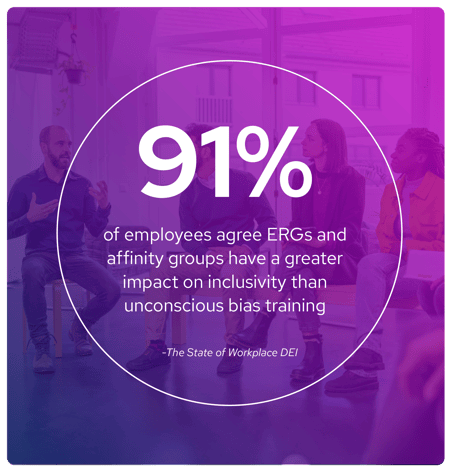 As employees increasingly see their companies as communities and environments for social change, employee-led groups are continuing to grow in prominence. In Benevity’s The State of Workplace DEI report, 71% of employees reported they have worked for a company offering ERGs or similar affinity groups at some point in their career. And among those who have worked at companies with these groups, 62% have participated — indicating strong interest.
As employees increasingly see their companies as communities and environments for social change, employee-led groups are continuing to grow in prominence. In Benevity’s The State of Workplace DEI report, 71% of employees reported they have worked for a company offering ERGs or similar affinity groups at some point in their career. And among those who have worked at companies with these groups, 62% have participated — indicating strong interest.
ERGs are a mainstay of DEI-focused companies
Now that we’ve passed the early groundswell of employee-led action on DEI, we’re entering a new phase where affinity and employee resource groups are a must-have — and possibly a more effective — component of a corporate DEI and culture strategy.
Eighty-eight percent of CSR leaders agree that DEI is being democratized and employees have increased levels of interest in ERGs and other peer-led initiatives. This was further affirmed when employees ranked ERGs as more beneficial than personal commitments to DEI from the CEO and other leaders by a wide margin — indicating employees believe in the power of ERGs and the passion of their peers more than the typical corporate approaches.
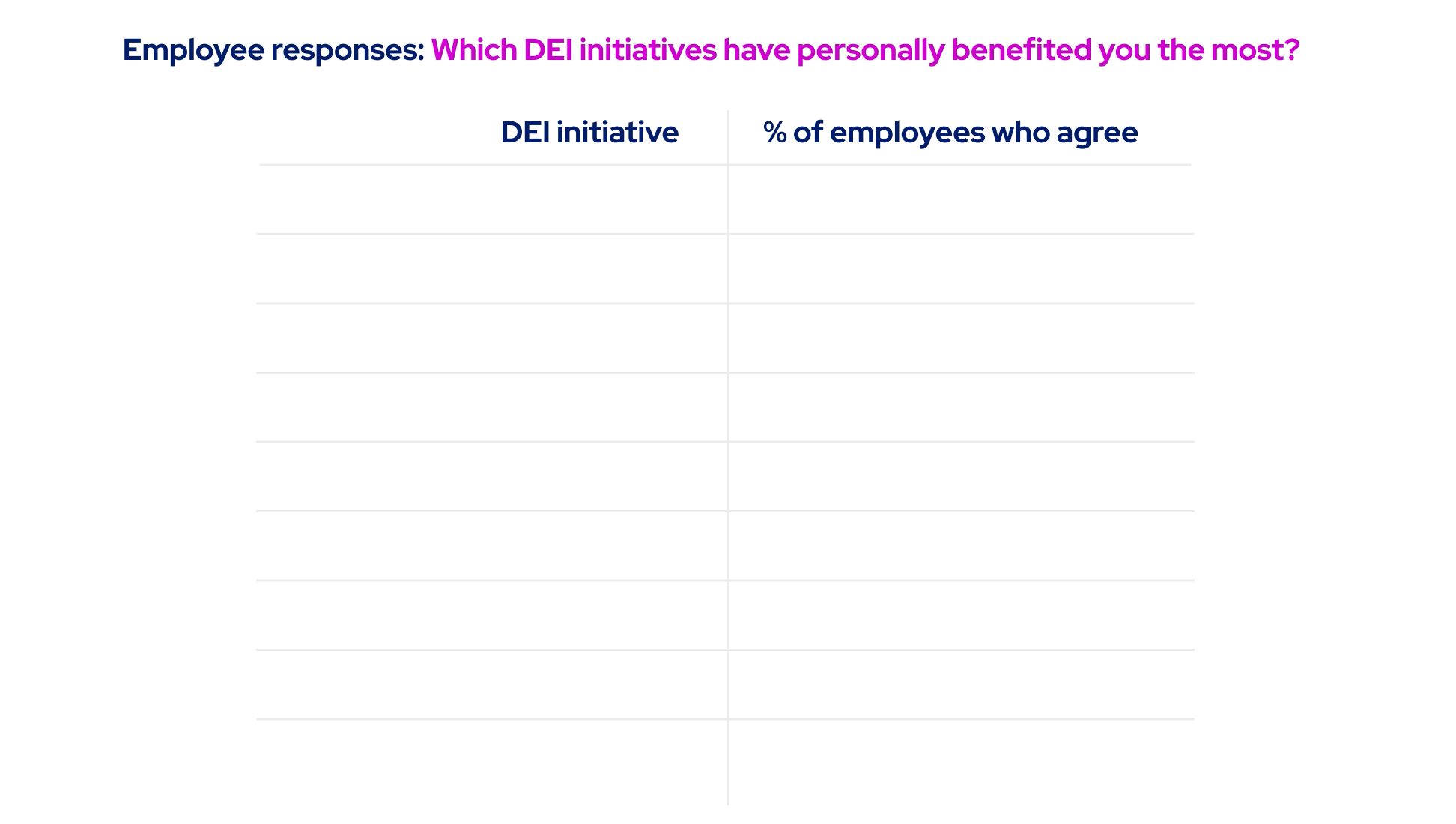
ERGs deliver more than just an inclusive workplace
Why are ERGs gaining so much momentum? Because they don’t just create more inclusive workplaces. They come with a host of other benefits that help to address the many complex issues that both companies and employees are wrestling with — from improving well-being, building allyship and creating belonging to providing opportunities for skills building and leadership development.
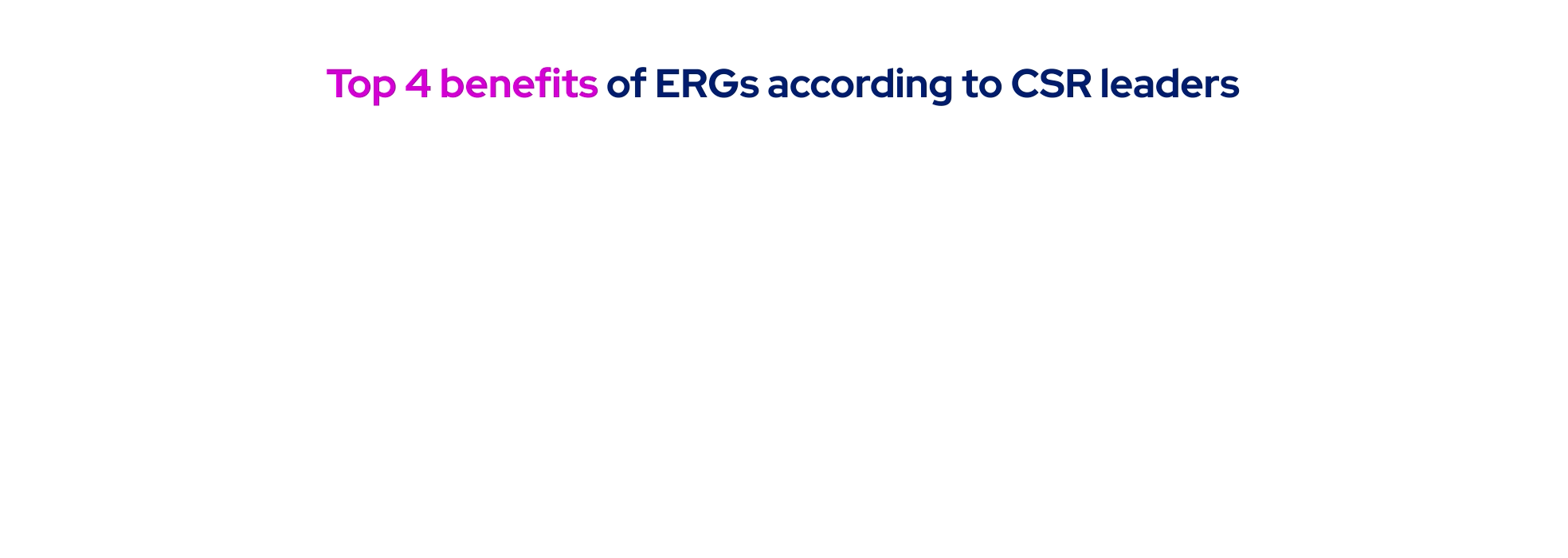
ERGs still have room to grow
Some 96% of employees agree ERGs will continue to be a critical DEI investment in 2023, despite economic pressure. And while DEI has become more democratized, and the impact of employee-led groups and initiatives is palpable, one-third of companies highlighted that ERGs are not as trusted as company-led DEI initiatives yet. DEI must be infused into the fabric of a company’s culture and their people’s experiences for them to realize the full benefit. This requires attention and support from all levels of the organization. Affinity and employee resource groups are an “and” not an “or” when it comes to moving the needle on social justice, equity and inclusion within a company. Both top-down and bottom-up action will be required in 2023 and beyond.
ESG is evolving toward positive impact
Environmental, social and governance (ESG) issues have rapidly risen in relevance in recent years and are increasingly topping board agendas. But when it comes to ESG reporting, corporate purpose leaders are split on its effectiveness and intended purpose. As it’s a reporting requirement primarily driven by investors and regulators, two-thirds of companies believe that ESG is mostly a risk management strategy, with one third believing it’s a good tool for impact. The one thing they all strongly agree on? Impact reporting is a critical investment for the future and it will be used to drive greater investment in social impact initiatives from their companies.

Ninety-four percent of CSR leaders say the demand for impact reporting is increasing, and 93% say they need to be able to confidently communicate their impact. This has led many to report that there needs to be a shift in priorities when considering ESG and impact.
From financial and impact materiality to generating positive outcomes
Today’s ESG ratings measure and mitigate financial risk for investors — but a new approach to reporting is emerging that shifts the focus from disclosures to positive outcomes. Why? Because a new generation of investors, employees and consumers is interested in another dimension beyond risk and compliance — they care about impact.
In 2023, employees, consumers and corporate purpose leaders all wish to make more informed decisions that will help them generate the most positive impact possible with their available resources — and they want to feel that sense of efficacy most of us look for when we give. So, it’s not surprising that individual and workplace donors are increasingly focused on whether their contributions are leading to concrete outcomes.
The biggest impact opportunity is on the human level — it’s about fulfilling the ultimate promise of philanthropy. When people give, they want to know their dollars are making a measurable difference to the causes or issues they care about. With the ability to choose from millions of nonprofits around the globe, donors need help understanding which organizations they can trust and what outcomes they can expect from their support. Research from the University of Pennsylvania tells us that with this kind of data, donors are more likely to increase their frequency of support over time, while increasing their own sense of happiness and well-being.
As a result, CSR leaders are looking for standardized data and reporting tools. For example, those offered by Impact Genome enable companies to understand the outcomes they are achieving, like providing people with regular access to affordable food, permanent housing or healthcare treatment services. And then they can benchmark their progress and impact over time and improve their investment decisions without burdening nonprofits with greater administrative work.
Achieving this level of impact and outcome transparency requires standardized data and guidance on giving based on an assessment of the impact generated by organizations — and it enables individuals to make choices that give them confidence.
If it is to realize its true potential, ESG will need to evolve to include a focus on positive impact. It will need to shift from measuring inputs and become a tool to drive increased positive internal and external impact — for companies and their people. Companies who measure and independently verify their impact will be ahead of the game when ESG reporting finally catches up to this.
Purpose keeps us afloat during uncertain times
Navigating uncertainty has been no easy task for companies and their people. Yet, purpose is sustaining us during difficult times in the world and in the office, and it has given us meaning and a guiding light to look to when we have more questions than answers. Purpose has solidified its importance in business — and in the world — as it continues to provide many solutions to the challenges we’re facing.
If companies continue to leverage purpose and see their social investments as a critical lever in building healthier individuals, businesses and communities, we’ll all come out stronger on the other side of uncertain times.
DATA SOURCES
Data and statistics cited in this report largely originate from the Benevity transactional database, where the aggregation of all activities happening in our software by our clients and their people are recorded, classified and stored. While transactions occur in many currencies, for ease and consistency the reference to dollars is always converted and shown in Canadian dollars (CA$). Secondary sources are utilized and cited when they provide statistics and illustrations of particular points being made in the text.
In January 2023, an online survey of CSR professionals was undertaken to assemble attitudes, beliefs and perceptions about many areas of corporate purpose. During this survey period, Benevity received responses from 230 individuals from a wide range of company sizes and industries in both our global client community and the broader North American corporate purpose sector.
GLOSSARY
♥ Volunteer acts of kindness
Volunteer acts of kindness are volunteering behaviors where the individual is dedicating time and energy to an initiative or a good deed that is not associated with a specific cause. It could include things like helping a neighbor in need, learning about a particular topic or participating in an activity that supports social good in ways not formally tied to a cause.
♦ Participation rate
Participation rate is the percentage of total users who were part of any of our clients’ employee giving, volunteering or micro-actions programs and did at least one action in the year — they may have made a donation, tracked volunteer time or completed a micro-action.



